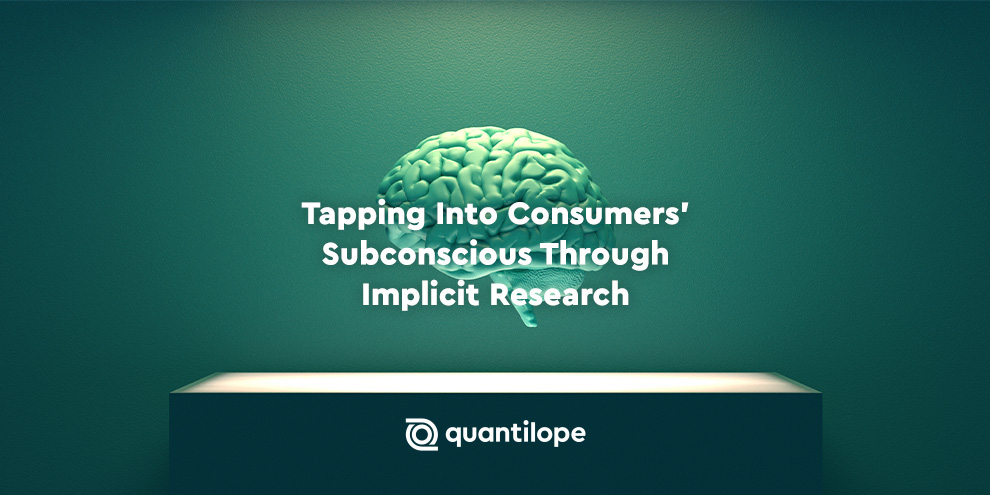Do you know how consumers really feel about your brand, communications or category?
Up to 95% of consumers’ purchase decisions take place in the subconscious mind and brands are increasingly using implicit research methods within their research studies in order to uncover subconscious associations to inform their brand, communications and product strategies. But what is implicit research and how does it work?
What is implicit research?
Among the different formats, methods and question types available for research teams to use, implicit research is unique as it has the ability to capture subconscious and unbiased associations consumers have toward a brand, product or category (or multiple brands, products and categories). Implicit reactions are measured primarily through the speed of selection (i.e., how quickly a respondent clicks on an association), capturing their gut reactions to research questions to get an authentic representation of how consumers feel toward something. There are two major types of implicit research: single implicit association tests (SAT) and multiple implicit association tests (MAT).
Implicit research doesn’t need to be expensive, time-consuming or complex to execute. Using an end-to-end platform, powered by AI, will shorten the time it takes to build an implicit research project and may save you money, compared to traditional agencies. Read on to find out how you can use this advanced method within your research studies, and uncover associations that consumers may not know they even have, with insights from quantilope’s Guide to Implicit Research.
How to tap into your consumers’ subconscious
Implicit research enriches consumer findings by uncovering true subconscious associations and capturing an unbiased reading of data. In explicit research, respondents may consider their answers after observing all information during a purchase experience or think carefully about specific brand ratings. In reality, consumers may have made up their mind quickly during a shopping experience or have preconceived beliefs on a brand, product or category; implicit research is able to accurately uncover these beliefs and quick decisions.
Furthermore, with implicit research, there is no order bias, wording bias, external influences, etc., so there’s no concern about how a question was posed to the respondent.
Implicit research is particularly useful when trying to understand an overall picture of your brand, product, communications or category, to see which associations authentically rise to the top versus those that a consumer selects from a list of associations. When respondents are shown a long list of elements, they tend to select many – even if they feel stronger about a select few; this is also why advanced analyses within implicit research methods are better at prioritizing long list items.
Use cases for implicit research
Brands use implicit research for a variety of purposes including:
- Category/industry associations: Understanding what consumers associate with the category to best position a new product for launch.
- Brand equity associations: Uncovering if people consider a brand familiar, nostalgic, luxurious, etc., or even a comparison of how two competitive brands’ associations differ from one another.
- Emotional and functional associations: Finding out how consumers are using products/services to help prioritize attention and budget on highest performing products, for example, learning which products are considered more convenient, less messy, more innovative or more powerful than others in the line.
- Message/advertising content recall: Identifying what consumers think of your communications, to help ensure advertising evokes the desired emotion and responses.
Want to run implicit research for your brand?
Explore implicit research in more detail with quantilope’s Guide to Implicit Research, which includes insights from our recent Streaming and Social Platforms Research Study and Consumer Electronics Study. Download the guide to learn:
- What implicit research entails.
- When to use implicit research.
- How to set up an implicit study.
- How to run implicit research with quantilope’s Insights Automation Platform.
Author
Alex Hall is associate director, research consulting, quantilope.
Alex Hall is a market research professional with nine years of experience at GfK, Ipsos and now quantilope. Hall leads the U.K. customer success team, a team of research consultants who support quantilope's UK customers across a range of verticals. Their goal is to empower clients to use quantilope's broad suite of research tools, who in turn bring substantive and quick results to their organization.
About quantilope
 quantilope automates consumer research to unlock high quality insights with speed and ease. Our Insights Automation Platform offers AI-driven advanced quantitative and qualitative solutions to support data-driven decision making. Founded in 2014, quantilope was named the No. 2 top technology provider for consumer research and one of the Top 50 most innovative suppliers for insights worldwide (Greenbook GRIT Business & Innovation Report 2022). quantilope powers consumer insights in brand awareness, market segmentation, advertising testing, product concepts and pricing analysis for over 300 brands including Nestle, Pepsi, Danone, Deutsche Telekom, PBS, OMD and more.
quantilope automates consumer research to unlock high quality insights with speed and ease. Our Insights Automation Platform offers AI-driven advanced quantitative and qualitative solutions to support data-driven decision making. Founded in 2014, quantilope was named the No. 2 top technology provider for consumer research and one of the Top 50 most innovative suppliers for insights worldwide (Greenbook GRIT Business & Innovation Report 2022). quantilope powers consumer insights in brand awareness, market segmentation, advertising testing, product concepts and pricing analysis for over 300 brands including Nestle, Pepsi, Danone, Deutsche Telekom, PBS, OMD and more.
References:

